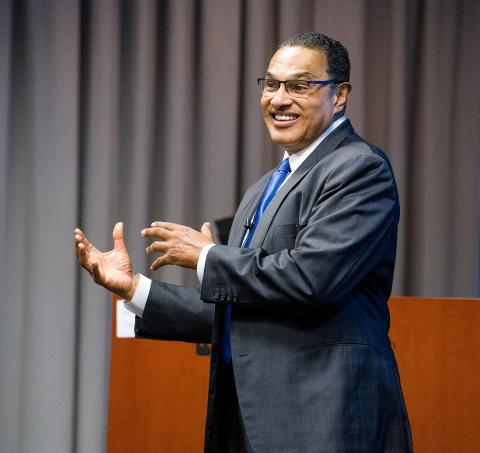UMBC President Advocates for Inclusive Excellence in Science

Photo: Andrew Propp
Getting through an advanced degree program in science is a bit like a long marriage: It takes commitment, the resolve to work through complex problems and sometimes help from outside sources. In America, only about a third of all students who start college as science majors will graduate with a science degree. What will it take to inspire smart students to pursue science, technology, engineering and math (STEM) and stick with it for the long haul?
Boosting the number of STEM graduates, including historically underrepresented minority populations, will require a change in culture, said Dr. Freeman Hrabowski III, president, University of Maryland-Baltimore County (UMBC). The mathematician and African-American advocate spoke at an NIMH Director’s Innovation Speaker Series lecture recently in the Neuroscience Center.
UMBC was a little-known commuter school when Hrabowski took the helm in 1992. In 2018, the university made sports history when it beat a top-ranked team in the NCAA men’s basketball tournament. “I was talking for at least a year about how we were the national cyber champions [to apathetic crowds]; then 2 hours of basketball and we became the darlings of America,” quipped Hrabowski.
Perhaps a lesser-known victory is UMBC’s climb, with Hrabowski’s guidance, to become one of the most innovative universities in the country, a model for undergraduate teaching, inclusion and STEM success. In fact, UMBC now produces more African Americans who go on to earn M.D.-Ph.D.s than any other institution in the country.
“We got to this point now where we know for a fact we can produce students of all races who can go on to excel and be excited about science,” said Hrabowski.
Some 50 years ago, this feat seemed unimaginable, he said, recollecting the inadequate resources and shoddy textbooks he had in school. “Imagine the psychological effect on children who know they’re so undervalued that they only get books from the school system after white children had finished with them,” he said. Back then, only the privileged seemed destined for college.

Photo: Andrew Propp
In 1965, only 10 percent of Americans graduated from college, including 11 percent of whites and 3 percent of blacks. Today, slightly more than 30 percent of American adults have bachelor’s degrees, including about 20 percent of blacks. There’s been great progress, said Hrabowski, but we have a long way to go.
“People of color—blacks, Hispanics, Native Americans—are terribly underrepresented,” he said. There’s an appallingly low percentage of Americans in general who have degrees in natural sciences or engineering, he added, and it’s even lower for minorities. “In 2018, there’s not one national agency in America that can tell me even 1 percent of the scientists are black.”
So how do we continue producing future generations of innovators from all backgrounds? It starts with changing culture and attitudes.
“We have to get away from the kind of approach that’s more cutthroat, [where] the first year of science is weed-out courses,” said Hrabowski. “Yes, we need rigor in academic standards, but you also need to talk about high levels of support.
“I would even argue, if I can be provocative, that it’s immoral to admit students in science to our institutions if they don’t have a reasonable chance of succeeding in science,” said Hrabowski. “The most stunning of all counterintuitive points is this: the higher the SATs, the larger the number of AP credits in science, the more prestigious the university the person attends, often the greater the probability the student will leave science in the first 2 years.”
Hrabowski has long touted four pillars of college success in science: high expectations for students, faculty, universities and national agencies; fostering a supportive community; researchers producing researchers by getting students into labs; and rigorous evaluation.
UMBC is busy putting these pillars into action, redesigning courses to make the teaching and learning process more engaging and fostering faculty-student connections.

Photo: Andrew Propp
“It’s great when we have faculty who care deeply about undergrad and grad students,” Hrabowski said, nodding to his colleague Dr. Jason Schiffman, a UMBC professor who works on mental illness research, “who will go with me into the residence halls and pull students into the work...When students see faculty as caring role models, they become excited about the possibilities for themselves.”
Hrabowski cited such programs as the Meyerhoff Scholars Program, created 30 years ago at UMBC, and HHMI [Howard Hughes Medical Institute] that offer resources to foster diversity among future STEM leaders. UMBC also recently started a program to help transition more postdocs of color into faculty positions.
“I challenge NIH to learn from the HHMI approach and partner with places that have shown demonstrated and inclusive excellence,” he said, encouraging leadership to create incentives and focus resources toward increasing minority representation in science.
“I challenge you, as I did [when I first spoke here] 10 years ago…to set some goals to take this to the next level.” With brainpower, creativity and staunch commitment, it can be done, Hrabowski said.
“I would argue as a proud American: We are better than this and we know we can do better than this for all kinds of people.”
